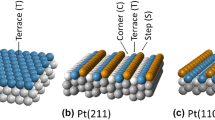Abstract
The effect of incident kinetic energy of colliding molecules or atoms on the outcome of activated reactions on metallic surfaces is of general interest in model heterogeneous catalysis. Previous studies have focused on small molecules involved in both direct molecule-surface collisions and collision induced processes. This work presents a study of the interaction of incoming energetic colliders, Ar and Kr, with the large molecule trimethylamine (TMA). In these experiments, the TMA is adsorbed on either a clean Ru(0001) surface or an oxygen covered Ru(0001). The results show that at an incident collider energy of 1.0–2.8 eV, collision induced desorption (CIDE) is the dominant reactivity pathway over collision induced dissociation (CIDI). These observations suggest that energy redistribution within the adsorbed molecule following collision is fast and prevents channeling of the collision energy to internal bond scission.








Similar content being viewed by others
References
Zeiri Y, Low JJ, Goddard WA (1986) A theoretical study of collision induced desorption spectroscopy from Si(111) surfaces., J Chem Phys 84(4):2408–2420
Beckerle JD, Yang QY, Johnson AD, Ceyer ST (1987) Collision-induced dissociative chemisorption of adsorbates: chemistry with a Hammer. J Chem Phys 86:7236
Beckerle JD, Johnson AD, Ceyer ST (1989) Observation and mechanism of collision-induced desorption: CH4on Ni(111). Phys Rev Lett 62:685
Beckerle JD, Johnson AD, Yang QY, Ceyer ST (1989) Collision-Induced dissociative chemisorption of CH4 on Ni(111) by inert-gas atoms—the mechanism for chemistry with a hammer. J Chem Phys 91(9):5756–5777
Szulczewski G, Levis RT (1993) A theory for calculating the surface-adsorbate bond dissociation energy from collision-induced desorption threshold measurements. J Chem Phys 98:5974
Akerlund C, Zoric I, Kasemo B (1996) A collision induced reaction: CO2 production on O2 and CO covered Pt(111. J Chem Phys 104:7359
Romm L, Zeiri Y, Asscher M (1998) Collision induced desorption of N2 from Ru(001). J Chem Phys 108:8605
Asscher M, Zeiri Y (2003) Surface processes induced by collisions., J Phys Chem 107(29):6903–6919
Asscher M, Somorjai GA (1992) In: Scoles G (ed) Atomic and molecular beam methods. vol 2, Ch. 17, Oxford University Press, Oxford
Walker BW, Stair PC (1981) The adsorption and decomposition of trimethylamine on the clean and oxidized Mo(100) surface. Surf Sci 103(2–3):315–337
Hallac B, Asscher M (2007) The chemistry of trimethylamine on Ru(001) and O/Ru(001). Langmuir 23:8891
Lilach Y (2003) Reactions of electronically excited molecules on surfaces, Ph.D. Thesis, The Hebrew University of Jerusalem
Lilach Y, Asscher M (2002) Compression and caging of CD3Cl by H2O layers on Ru(001). J Chem Phys 117(14):6730–6736
Romm L, Katz G, Kosloff R, Asscher M (1997) Dissociative chemisorption of N2 on Ru(001) enhanced by kinetic and vibrational energy: molecular beam experiments and quantum mechanical calculations. J Phys Chem B101:2213–2217
Acknowledgements
This work was partially supported by the Israel Science Foundation (ISF) and the German Israel Foundation (GIF). The help of Michelle Akerman is greatly appreciated.
Author information
Authors and Affiliations
Corresponding author
Electronic supplementary material
Below is the link to the electronic supplementary material.
Rights and permissions
About this article
Cite this article
Hallac, B., Asscher, M. Collision Induced Desorption of Large Molecules From Surfaces: Trimethylamine Removal from Ru(0001). Top Catal 61, 776–783 (2018). https://doi.org/10.1007/s11244-018-0921-6
Published:
Issue Date:
DOI: https://doi.org/10.1007/s11244-018-0921-6




